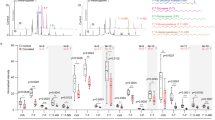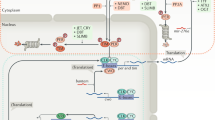Abstract
DIAPAUSE is a state of arrested development which synchronises insect activity cycles with seasons when food resources are available. Facultative diapause occurs in response to environmental cues such as photoperiod and temperature which influence the endocrine system before the unfavourable conditions arrive1,2. We have now obtained evidence that the currently accepted theory of humoral regulation of larval diapause should be revised. Past research on the pupal diapause of Saturniid moths led to the widely accepted conclusion that larval and pupal diapause result from a failure of the neurosecretory cells of the brain or the corpora cardiaca to release the brain (prothoracotropic) hormone which is required to stimulate the prothoracic glands to secrete the moulting hormone, ecdysone3–5. The arrest of growth and moulting and the initiation of diapause have therefore been attributed to the absence of this brain hormone from the haemolymph6. Available evidence linking larval diapause with an inactive endocrine system has, however, remained inconclusive7–10. Our data indicate that, on the contrary, mature diapause larvae of the southwestern corn borer, Diatraea grandiosella Dyar, must retain a functional endocrine system since they undergo stationary ecdyses during diapause. The ability of diapause larvae to undergo stationary ecdyses remains consistent with the concept of diapause as a state of arrested development because the stationary ecdyses do not affect the developmental stage11. (Lüscher used the term stationary ecdysis to describe the ecdysis of the pseudergate larvae of the termite, Kalotermes flavicollis, when no progressive development occurs.) We now have evidence to implicate juvenile hormone (JH) in the regulation of this larval diapause.
This is a preview of subscription content, access via your institution
Access options
Subscribe to this journal
Receive 51 print issues and online access
$199.00 per year
only $3.90 per issue
Buy this article
- Purchase on Springer Link
- Instant access to full article PDF
Prices may be subject to local taxes which are calculated during checkout
Similar content being viewed by others
References
Lees, A. D., The Physiology of Diapause in Arthropods (Cambridge University Press, 1955).
Danilevskii, A. S., Photoperiodism and Seasonal Development of Insects (Oliver and Boyd, Edinburgh, 1965).
Williams, C. M., Biol. Bull., 90, 234 (1946).
Williams, C. M., Biol. Bull., 103, 120 (1952).
Highnam, K. C., and Hill, L., The Comparative Endocrinology of the Invertebrates (Arnold, London, 1969).
Wigglesworth, V. B., Adv. Insect Physiol., 2, 247 (1964).
Hinton, H. E., Entomologist, 86, 279 (1954).
Church, N. S., Can. J. Zool., 33, 339 (1955).
Cloutier, E. J., Beck, S. D., McLeod, D. G. R., and Silhacek, D. L., Nature, 195, 1222 (1962).
Beck, S. D., in Evolution and Environment (edit. by Drake, E. T.), 279 (Yale University Press, New Haven, 1968).
Lüscher, M., Proc. R. ent. Soc. London, 1, 57 (1961).
Jacob, D., and Chippendale, G. M., Ann. ent. Soc. Am., 64, 485 (1971).
Chippendale, G. M., and Reddy, A. S., J. Insect Physiol., 19, 1397 (1973).
Chippendale, G. M., and Reddy, A. S., Ann. ent. Soc. Am., 65, 882 (1972).
Mansingh, A., Can. Ent., 103, 983 (1971).
Harvey, W. R., A. Rev. Ent., 7, 57 (1962).
Beck, S. D., and Hanec, W., Insect Physiol., 4, 304 (1960).
Salt, R. W., A. Rev. Ent., 6, 55 (1961).
Beck, S. D., Insect Photoperiodism (Academic Press, New York, 1968).
Chippendale, G. M., Insect Biochem., 1, 39 (1971).
Chippendale, G. M., Entomologia exp. appl., 16, 395 (1973).
Alexander, B. A., and Chippendale, G. M., Ann. ent. Soc. Am., 66, 747 (1973).
Yin, C.-M., and Chippendale, G. M., J. Insect Physiol. (in the press).
Fukaya, M., and Mitsuhashi, J., Bull. natn. Inst. agric. Sci., C 13, 1 (1961).
Author information
Authors and Affiliations
Rights and permissions
About this article
Cite this article
CHIPPENDALE, G., YIN, CM. Endocrine Activity retained in Diapause Insect Larvae. Nature 246, 511–513 (1973). https://doi.org/10.1038/246511a0
Received:
Revised:
Issue Date:
DOI: https://doi.org/10.1038/246511a0
This article is cited by
Comments
By submitting a comment you agree to abide by our Terms and Community Guidelines. If you find something abusive or that does not comply with our terms or guidelines please flag it as inappropriate.



